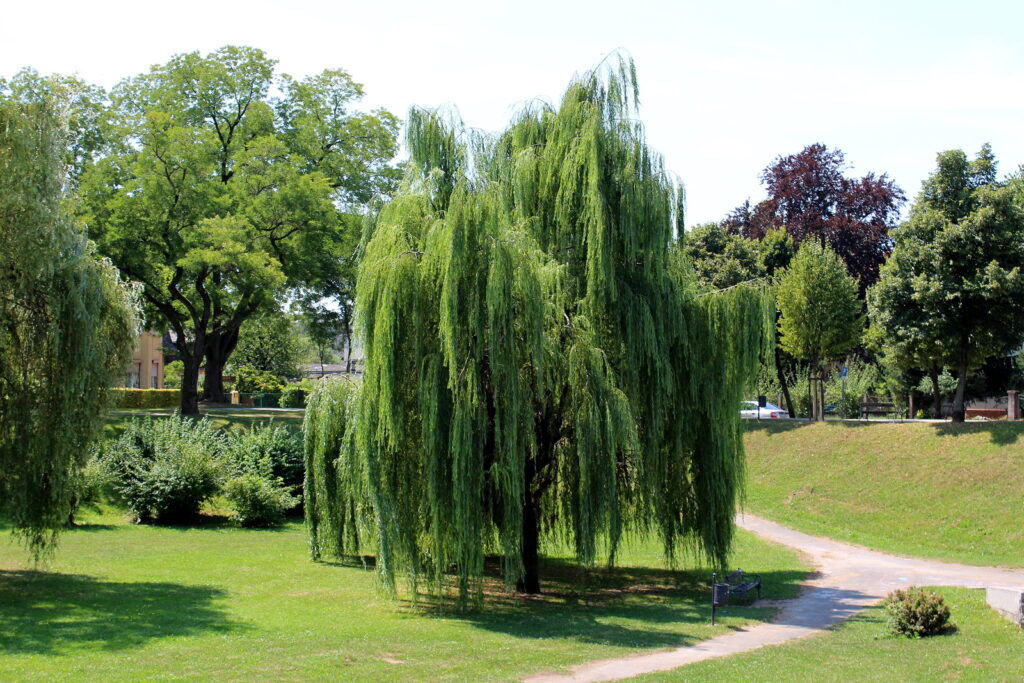Salix is a genus of deciduous trees commonly called willows. Willows come in diverse forms. There are large willows best suited for large gardens, smaller willows that can be used as specimens in small gardens, shrubby willows suited for shrub borders, and often grown for their catkins–called “pussy willows.” But, perhaps the best known are weeping willows that are often featured near water where their striking form is reflected.
Willows are fast-growing and generally weak wooded. Their roots are shallow and invasive so it is important that they be planted where they will not interfere with the growth of other plants.
Willows leaf out early in spring and hold their leaves past when other trees drop their leave. They can be trained s shade trees for patios and sitting areas,
Salix is a genus of about 300 species. Willows are found worldwide except in Australia.

Get to know Salix
- Plant type: Deciduous shrubs or trees
- Growing zones and range:
- Hardiness:
- Height and width: 50-70 feet (15.2-21.3m)
- Growth rate: Fast
- Form and habit: Huge weeping
- Foliage: Simple, entire or toothed, usually alternate leaves, lustrous green turning to gold in fall; flexible whiplike branches and long lance-shaped leaves
- Flowers: Very small, golden catkins
- Fruits: Capsule
- Uses: Landscape, hanging over ponds and streams, garden specimen, hedges, screens, shrub borders, and cutting arrangements
- Common name: Willows
- Botanical name: Salix
- Family name: Salicaceae
- Origin: Distributed worldwide, except Australia
Where to plant Salix
- Plant Salix in full sun; tolerate partial shade.
- Plant Salix in deep, moist, moderately fertile soil; they tolerate poor drainage, but dislike shallow alkaline soil.
When to plant Salix
- Set container-grown Salix in the garden in fall and early spring.

Planting and spacing Salix
- Salix are weak wooded and messy, so site them with care.
- Salix are handsome in pondside plantings, but their aggressive roots can tear rubber liners. Keep them away from water mains and septic systems.
- All Salix have shallow roots and are hard to garden under.
- Plant most Salix 50 feet (15m) apart or more.
How to water and feed Salix
- Give Salix lots of water.
- Feed Salix with an all-purpose organic fertilizer in spring
How to care for Salix
- Prune Salix in summer or fall; may bleed if pruned in winter or spring.
- For those grown for colored winter shoots, and to rejuvenate old plants, prune every 1-3 years.
- Because their weeping boughs are often long enough to touch the ground, it is important to trim off the lower branches of young trees so that the first limbs will be high enough off the ground to allow headroom.
Salix pests and diseases
- Salix are prone to develop canker and fungal diseases, crown gall, dieback, root knot nematode, powdery mildew, lesion nematode, mushroom root rot, tar spot, rust, twig blight, and heart rot.
- Most Salix are subject to borers, caterpillars, aphids, scale insects, blights, cankers, and other problems.
- Mulch Salix with organic matter to keep soil evenly moist.
- Avoid injury with gardening tools; such wounds are a common entry point for pests and diseases.
- If caterpillars attack, spray small plants with BT.

Salix propagation
- Propagate Salix from cuttings anytime.
- Root softwood cuttings in spring, or hardwood cuttings in winter; most root very easily.
Salix varieties to grow
- S. alba, ‘Tristis’, Niobe willow, Golden weeping willow, also listed as S. x sepulcris ‘Chrysocoma’. This popular tree forms a large, rounded canopy of long, gracefully weeping branches and grows 50-70 feet (15.2-21.3m) tall and wide. The trunk and main branches are massive and cloaked in rough brown bark. The slender weeping branches and twigs feature bright gold bark that is especially pretty in winter. Leaves are narrow and lance shaped, measure 4 inches (10.2cm) long and .5 inch (1.3cm) wide, and have whitish undersides. They are bright yellow-green very early in spring, mature to dark green with silver undersides in summer, and change to golden yellow in late fall. Plant Niobe willow beside a pond or stream, where its form will be reflected in the water, or use it in any informal site with moist to wet soil. Avoid groomed areas, as it is messy, and keep away from water mains. Attacked by many insects and diseases, including twig blight, gall, canker, aphids, borers, and sawflies. From Europe, northern Africa, and western and central Asia. Zones 3 to 9.
- S. babylonica, Weeping willow, tree. To 30-50 feet (9.1-15.2m), with equal or greater spread. Smaller than other willows, with longer—3-6 inch (7.6-15.2cm)—leaves and even more pronounced weeping habit. Greenish or brown branchlets.
- S. blanda, Wisconsin weeping willow, tree. To 40-50 feet (12.2-15.2m) or more, spreading wider with weeping shoots, and lance-shaped, tapered, glossy, dark green leaves, to 6 inches (15cm) long. Slender, silvery green, usually female catkins, to 1.25 inch (3cm) long, are produced in spring, with the leaves. To 40 feet (12m) tall and wide. Hybrid of S. babylonica but less strongly weeping, with broader leaves of a more bluish green color.
- S. caprea, French pussy willow, the Latin-derived species name refers to goats, since this plant was once used for fodder, and another common name is goat willow. It is upright and often treelike at 25 feet (7.6m) tall and 15 feet (4.6m) wide and bears pink-gray wooly catkins in early spring.
- S. discolor, Pussy willow, shrub or small tree. Slender stems are red brown; 2-4 inches (5.1-10.2cm) leaves are bright green above, bluish beneath. Catkins of male plants (usually only kind sold) are the feature attraction—soft, silky, pearly gray, to 1.5 inch (3.8cm) long.
- S. elegantissima, Thurlow weeping willow, grows 30-50 feet (9.1-15.2m) tall and has dull green leaves 3-6 inches (7.6-15.2cm) long and about .5 inch (1.3cm) wide. It is a hybrid rather similar to S. blanda, except that its pendulous branches are twice as long.
- S. x sepulcralis ‘Chrysocoma’ (S. alba ‘Tristis’), Golden weeping willow, fast-growing, wide-spreading tree with slender, golden yellow shoots, pendent to the ground, and narrowly lance-shaped, tapered, bright green leaves, to 5 inches (13cm) long, both yellow males and green females are often present on the same plant, are produced with the leaves, in spring. To 50 feet (15m) tall and wide.















